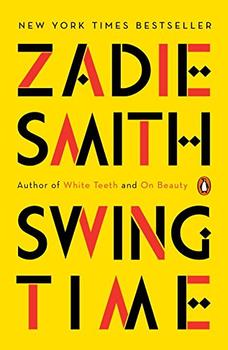Summary | Excerpt | Reviews | Beyond the Book | Readalikes | Genres & Themes | Author Bio

Here is the steeple
Open the doors
There's all the people.
The stained glass told the story of St. Christopher carrying the baby Jesus on his shoulders across a river. It was poorly done: the saint looked mutilated, one-armed. The original windows had blown out during the war. Opposite St. Christopher's stood a high-rise estate of poor reputation, and this was where Tracey lived. (Mine was nicer, low-rise, in the next street.) Built in the sixties, it replaced a row of Victorian houses lost in the same bombing that had damaged the church, but here ended the relationship between the two buildings. The church, unable to tempt residents across the road for God, had made a pragmatic decision to diversify into other areas: a toddlers' playgroup, ESL, driver training. These were popular, and well established, but Saturday-morning dance classes were a new addition and no one knew quite what to make of them. The class itself cost two pounds fifty, but a maternal rumor went round concerning the going rate for ballet shoes, one woman had heard three pounds, another seven, so-and-so swore the only place you could get them was Freed, in Covent Garden, where they'd take ten quid off you as soon as look at you - and then what about "tap" and what about "modern?" Could ballet shoes be worn for modern? What was modern? There was no one you could ask, no one who'd already done it, you were stuck. It was a rare mother whose curiosity extended to calling the number written on the homemade flyers stapled to the local trees. Many girls who might have made fine dancers never made it across that road, for fear of a homemade flyer.
My mother was rare: homemade flyers did not scare her. She had a terrific instinct for middle-class mores. She knew, for example, that a car-boot sale - despite its unpromising name - was where you could find a better quality of person, and also their old Penguin paperbacks, sometimes by Orwell, their old china pill-boxes, their cracked Cornish earthenware, their discarded potter's wheels. Our flat was full of such things. No plastic flowers for us, sparkly with fake dew, and no crystal figurines. This was all part of the plan. Even things I hated - like my mother's espadrilles -
usually turned out to be attractive to the kind of people we were trying to attract, and I learned not to question her methods, even when they filled me with shame. A week before classes were due to begin I heard her doing her posh voice in the galley kitchen, but when she got off the phone she had all the answers: five pounds for ballet shoes - if you went to the shopping center instead of up into town - and the tap shoes could wait till later. Ballet shoes could be used for modern. What was modern? She hadn't asked. The concerned parent she would play, but never, ever the ignorant one.
My father was sent to get the shoes. The pink of the leather turned out to be a lighter shade than I'd hoped, it looked like the underside of a kitten, and the sole was a dirty gray cat's tongue, and there were no long pink satin ribbons to criss-cross over the ankles, no, only a sad little elastic strap which my father had sewn on himself. I was extremely bitter about it. But perhaps they were, like the espadrilles, deliberately "simple," in good taste? It was possible to hold on to this idea right up to the moment when, having entered the hall, we were told to change into our dance clothes by the plastic chairs and go over to the opposite wall, to the barre. Almost everybody had the pink satin shoes, not the pale pink, piggy leather I was stuck with, and some - girls whom I knew to be on benefits, or fatherless, or both - had the shoes with long satin ribbons, criss-crossing round their ankles. Tracey, who was standing next to me, with her left foot in her mother's hand, had both - the deep pink satin and the criss-cross - and also a full tutu, which no one else had even considered as a possibility, no more than turning up to a first swimming lesson in a diving suit. Miss Isabel, meanwhile, was sweet-faced and friendly, but old, perhaps as old as forty-five. It was disappointing. Solidly constructed, she looked more like a farmer's wife than a ballet dancer and was all over pink and yellow, pink and yellow. Her hair was yellow, not blond, yellow like a canary. Her skin was very pink, raw pink, now that I think of it she probably suffered from rosacea. Her leotard was pink, her tracksuit bottoms were pink, her cover-up ballet cardigan was mohair and pink - yet her shoes were silk and yellow, the same shade as her hair. I was bitter about this, too. Yellow had never been mentioned! Next to her, in the corner, a very old white man in a trilby sat playing an upright piano, "Night and Day," a song I loved and was proud to recognize. I got the old songs from my father, whose own father had been a keen pub singer, the kind of man - or so my father believed - whose petty criminality represents, at least in part, some thwarted creative instinct.
Excerpted from Swing Time by Zadie Smith. Copyright © 2016 by Zadie Smith. All rights reserved. No part of this excerpt may be reproduced or reprinted without permission in writing from the publisher.
Your guide toexceptional books
BookBrowse seeks out and recommends the best in contemporary fiction and nonfiction—books that not only engage and entertain but also deepen our understanding of ourselves and the world around us.